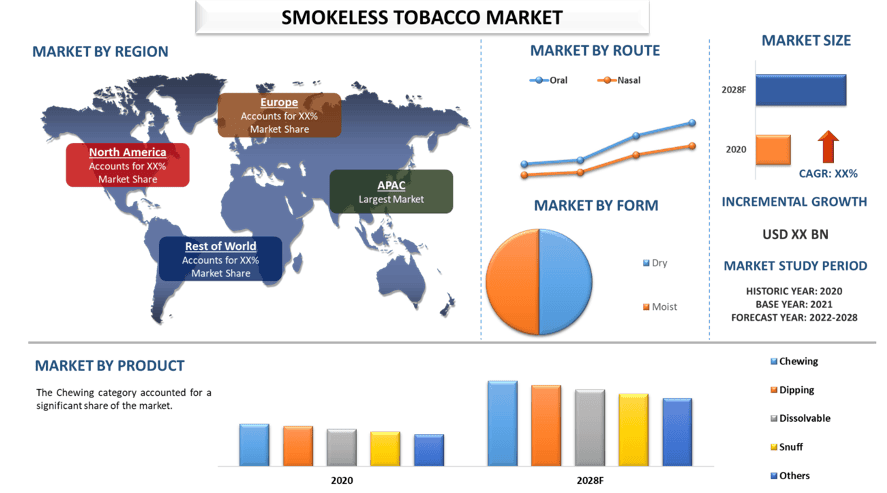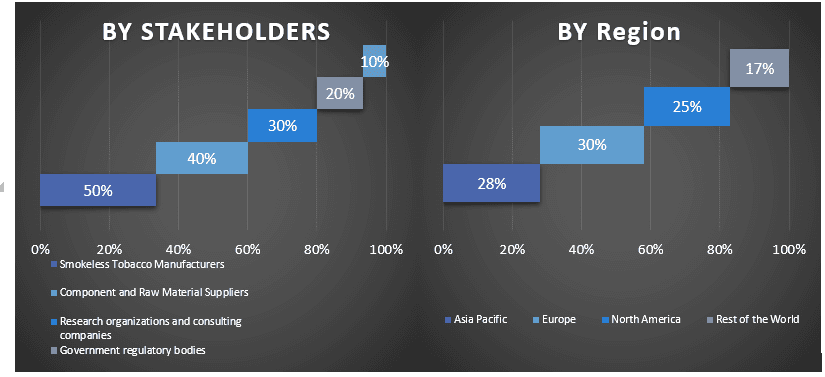- Strona główna
- O nas
- Branża
- Usługi
- Czytanie
- Kontakt
Rynek bezdymnego tytoniu: aktualna analiza i prognoza (2022-2028)
Nacisk na produkt (Żucie, Zanurzanie, Rozpuszczalny, Tabaka, Inne); Forma (Sucha, Wilgotna); Droga podania (Doustna, Donosowa); Kanał dystrybucji (Sklepy stacjonarne, Sklepy internetowe); oraz Region/Kraj

Oczekuje się, że rynek tytoniu bezdymnego odnotuje CAGR na poziomie około 5% w okresie 2022-2028. Tytoń bezdymny odnosi się do tytoniu, który nie jest spalany ani palony i zawiera nikotynę oraz inne rakotwórcze substancje chemiczne. Produkty te są spożywane doustnie lub donosowo i są dostępne w różnych formach lub typach na rynku. Większość wyrobów tytoniowych bezdymnych jest również spożywana poprzez żucie, wciąganie lub umieszczanie tytoniu między dziąsłami a zębami w jamie ustnej. Rosnącą popularność tytoniu bezdymnego można przypisać łatwej dostępności tych rodzajów produktów, które silnie uzależniają, zawierają nikotynę i są dostępne w różnych formach spożycia, ale wiążą się z pewnymi negatywnymi skutkami dla życia i zdrowia człowieka, takimi jak zwiększenie ryzyka raka jamy ustnej, gardła i trzustki. Tytoń bezdymny zwiększa również ryzyko rozwoju małych białych plam w jamie ustnej zwanych leukoplakią. Według CDC w 2020 r. odsetek dorosłych, którzy zgłosili bieżące używanie tytoniu bezdymnego, był najwyższy wśród osób mieszkających na południu USA (2,7%) i na środkowym zachodzie USA (2,6%). Ponadto przewiduje się, że rynek tytoniu bezdymnego będzie rósł z powodu rosnącej świadomości wśród osób na całym świecie na temat szkodliwych skutków tytoniu bezdymnego.
Tytoń bezdymny zyskuje na popularności w większości części świata, gdzie widać, że największe firmy tytoniowe na świecie inwestują więcej w jego produkcję ze względu na presję wynikającą z prawodawstwa dotyczącego tytoniu. Jak wspomniano powyżej, tytoń bezdymny występuje w różnych smakach, które przemawiają do młodych ludzi. Na przykład, we wrześniu 2020 r. JTI (Japan Tobacco International) rozszerzyło swoje technologiczne strategiczne partnerstwo z Sauber Engineering AG (SEN), liderem w dziedzinie rozwoju technologii i prototypów oraz członkiem Sauber Group of Companies. Dzięki tej współpracy obie firmy będą kontynuować współpracę nad precyzyjnymi projektami inżynieryjnymi mającymi na celu poprawę wydajności produktów Grupy JT następnej generacji.
Altria Group Inc., British American Tobacco PLC, Imperial Brands PLC, Japan Tobacco Inc., Swedish Match AB, Swisher International Group, Philip Morris International, Mac Baren Tobacco company, Reynolds American, Inc., Universal Corporation Ltd to niektórzy z kluczowych graczy na rynku. Gracze ci podejmują szereg fuzji i przejęć wraz z partnerstwami, aby ułatwić klientom korzystanie z zaawansowanych technologicznie i innowacyjnych produktów/technologii.
Informacje przedstawione w raporcie
"Wśród produktów kategoria tytoniu do żucia stanowiła większość udziału w rynku w 2020 r."
Na podstawie produktu rynek jest podzielony na tytoń do żucia, tytoń do zanurzania, tytoń rozpuszczalny, tabakę i inne. Wśród produktów kategoria tytoniu do żucia stanowiła znaczący udział w rynku ze względu na rosnący popyt na luźne liście, a woreczki do żucia stanowią impuls dla tego segmentu rynku tytoniu bezdymnego. Wysoka wygoda konsumpcji zapewniana przez woreczki do żucia może przyciągnąć dużą uwagę do różnych dostępnych na rynku rozwiązań, co może prowadzić do ekspansji rynku tytoniu bezdymnego. Ponadto niska i efektywna cena wyrobów tytoniowych do żucia prawdopodobnie przyspieszy wzrost segmentu.
"Oczekuje się, że wśród form sucha forma odnotuje znaczny CAGR w okresie prognozy"
Na podstawie formy rynek jest podzielony na suchą i wilgotną. Wśród nich oczekuje się, że forma sucha odnotuje najwyższy CAGR w okresie prognozy. Wynika to ze wzrostu preferencji i wzrostu spożycia tytoniu suchego wśród młodego pokolenia, co przyczynia się do wzrostu segmentu. Ponadto dłuższy okres trwałości tytoniu suchego w porównaniu z tytoniem wilgotnym prawdopodobnie pomoże segmentowi wzrostu rynku.
"Wśród dróg podania kategoria doustna stanowiła większość udziału w rynku w 2020 r."
Na podstawie drogi podania rynek jest podzielony na doustną i donosową. Wśród nich kategoria doustna stanowiła znaczący udział w rynku ze względu na rosnący popyt na tytoń do żucia, ponieważ droga doustna jest zwykle preferowaną drogą spożycia tytoniu bezdymnego, co przyczynia się do wzrostu segmentu. Na przykład, nowe doustne produkty nikotynowe, często nazywane przez przemysł tytoniowy nowoczesną nikotyną doustną, pojawiają się wśród dużych firm tytoniowych (np. RJ Reynolds, Swedish Match i British American Tobacco). Zazwyczaj występują one w postaci saszetek, ale mogą również występować w innych formach, takich jak tabletki rozpuszczalne.
"Wśród kanałów dystrybucji kategoria sklepów stacjonarnych stanowiła większość udziału w rynku w 2020 r."
Na podstawie kanałów dystrybucji rynek jest podzielony na sklepy stacjonarne i sklepy internetowe. Wśród kanałów dystrybucji kategoria sklepów stacjonarnych stanowiła znaczący udział w rynku. Można to przypisać możliwości sprawdzenia jakości produktów w sklepach detalicznych przed zakupem, co przyspiesza wzrost tego segmentu. Ponadto rosnąca liczba sklepów tytoniowych, atrakcyjne opakowania i smaczne, modne produkty przyczyniają się do sprzedaży wyrobów tytoniowych bezdymnych w sklepach stacjonarnych.
"Azja i Pacyfik będą świadkami znacznego wzrostu w okresie prognozy"
Aby lepiej zrozumieć dynamikę rynku tytoniu bezdymnego, przeprowadzono szczegółową analizę dla różnych regionów na całym świecie, w tym Ameryki Północnej (USA, Kanada i reszta Ameryki Północnej), Europy (Niemcy, Francja, Hiszpania, Wielka Brytania, Włochy i reszta Europy), Azji i Pacyfiku (Chiny, Indie, Australia, Japonia i reszta regionu APAC) oraz reszty świata. Azja i Pacyfik stanowią główny rynek dla przemysłu tytoniu bezdymnego i generują przychody ze względu na wzrost spożycia tytoniu bezdymnego w regionie.
Powody, dla których warto kupić ten raport:
- Badanie obejmuje analizę wielkości rynku i prognozowania, zatwierdzoną przez uwierzytelnionych kluczowych ekspertów branżowych.
- Raport przedstawia szybki przegląd ogólnej wydajności branży na pierwszy rzut oka.
- Raport obejmuje dogłębną analizę wybitnych graczy z branży, z głównym naciskiem na kluczowe dane finansowe przedsiębiorstwa, portfel produktów, strategie ekspansji i najnowsze wydarzenia.
- Szczegółowe badanie czynników napędzających, ograniczeń, kluczowych trendów i możliwości występujących w branży.
- Badanie kompleksowo obejmuje rynek w różnych segmentach.
- Dogłębna analiza branży na poziomie regionalnym.
Opcje dostosowania:
Globalny rynek tytoniu bezdymnego można dodatkowo dostosować zgodnie z wymaganiami lub dowolnym innym segmentem rynku. Poza tym UMI rozumie, że możesz mieć własne potrzeby biznesowe, dlatego zachęcamy do kontaktu z nami, aby uzyskać raport, który w pełni odpowiada Twoim wymaganiom.
Spis treści
Metodologia badań dla globalnej analizy rynku tytoniu bezdymnego (2021-2027)
Analiza historycznego rynku, szacowanie obecnego rynku i prognozowanie przyszłego rynku globalnego rynku tytoniu bezdymnego to trzy główne kroki podjęte w celu stworzenia i analizy adopcji tytoniu bezdymnego w głównych regionach na świecie. Przeprowadzono wyczerpujące badania wtórne w celu zebrania danych historycznych o rynku i oszacowania obecnej wielkości rynku. Po drugie, aby zweryfikować te spostrzeżenia, wzięto pod uwagę liczne ustalenia i założenia. Ponadto przeprowadzono również wyczerpujące wywiady pierwotne z ekspertami branżowymi w całym łańcuchu wartości globalnego rynku tytoniu bezdymnego. Po założeniu i walidacji danych rynkowych poprzez wywiady pierwotne, zastosowaliśmy podejście odgórne/oddolne do prognozowania całkowitej wielkości rynku. Następnie przyjęto metody podziału rynku i triangulacji danych w celu oszacowania i analizy wielkości rynku segmentów i podsegmentów, do których należy branża. Szczegółowa metodologia została wyjaśniona poniżej:
Analiza historycznej wielkości rynku
Krok 1: Dogłębne badanie źródeł wtórnych:
Przeprowadzono szczegółowe badanie wtórne w celu uzyskania historycznej wielkości rynku tytoniu bezdymnego za pośrednictwem wewnętrznych źródeł firmy, takich jak raport roczny i sprawozdania finansowe, prezentacje wyników, komunikaty prasowe itp., oraz źródeł zewnętrznych, w tym czasopism, wiadomości i artykułów, publikacji rządowych, publikacji konkurencji, raportów sektorowych, baz danych stron trzecich i innych wiarygodnych publikacji.
Krok 2: Segmentacja rynku:
Po uzyskaniu historycznej wielkości rynku tytoniu bezdymnego przeprowadziliśmy szczegółową analizę wtórną w celu zebrania historycznych informacji o rynku oraz udziału w rynku dla różnych segmentów i podsegmentów dla głównych regionów. Główne segmenty uwzględnione w raporcie to produkt, forma, droga i kanał dystrybucji. Przeprowadzono dalsze analizy na poziomie krajowym w celu oceny ogólnej adopcji modeli testowania w danym regionie.
Krok 3: Analiza czynnikowa:
Po uzyskaniu historycznej wielkości rynku różnych segmentów i podsegmentów przeprowadziliśmy szczegółową analizę czynnikową w celu oszacowania obecnej wielkości rynku tytoniu bezdymnego. Ponadto przeprowadziliśmy analizę czynnikową przy użyciu zmiennych zależnych i niezależnych, takich jak wygodne użytkowanie, niższy koszt, przyjemny smak i niższe ryzyko dla zdrowia w porównaniu z paleniem tytoniu. Przeprowadzono dokładną analizę scenariuszy popytowo-podażowych, biorąc pod uwagę najważniejsze partnerstwa, fuzje i przejęcia, ekspansję biznesową i wprowadzenie produktów na rynek w sektorze tytoniu bezdymnego na całym świecie.
Szacowanie obecnej wielkości rynku i prognoza
Określanie obecnej wielkości rynku: Na podstawie praktycznych spostrzeżeń z powyższych 3 kroków doszliśmy do obecnej wielkości rynku, kluczowych graczy na globalnym rynku tytoniu bezdymnego oraz udziałów w rynku poszczególnych segmentów. Wszystkie wymagane udziały procentowe i podziały rynku zostały określone przy użyciu wspomnianego powyżej podejścia wtórnego i zweryfikowane poprzez wywiady pierwotne.
Szacowanie i prognozowanie: Do szacowania rynku i prognozowania przypisano wagi różnym czynnikom, w tym czynnikom napędzającym i trendom, ograniczeniom i możliwościom dostępnym dla zainteresowanych stron. Po przeanalizowaniu tych czynników zastosowano odpowiednie techniki prognozowania, tj. podejście odgórne/oddolne, aby dojść do prognozy rynkowej na rok około 2027 dla różnych segmentów i podsegmentów na głównych rynkach na świecie. Metodologia badań przyjęta w celu oszacowania wielkości rynku obejmuje:
- Wielkość rynku branży, pod względem przychodów (USD) i wskaźnika adopcji rynku tytoniu bezdymnego na głównych rynkach krajowych
- Wszystkie udziały procentowe, podziały i zestawienia segmentów i podsegmentów rynku
- Kluczowi gracze na globalnym rynku tytoniu bezdymnego pod względem oferowanych rozwiązań. Ponadto strategie wzrostu przyjęte przez tych graczy, aby konkurować na szybko rozwijającym się rynku
Walidacja wielkości i udziału w rynku
Badania pierwotne: Przeprowadzono dogłębne wywiady z kluczowymi liderami opinii (KOL), w tym kadrą kierowniczą najwyższego szczebla (CXO/VPs, szef działu sprzedaży, szef działu marketingu, szef działu operacyjnego i szef regionu, szef kraju itp.) w głównych regionach. Wyniki badań pierwotnych zostały następnie podsumowane i przeprowadzono analizę statystyczną w celu udowodnienia postawionej hipotezy. Dane wejściowe z badań pierwotnych zostały skonsolidowane z wynikami badań wtórnych, przekształcając w ten sposób informacje w praktyczne spostrzeżenia.
Podział uczestników pierwotnych w różnych regionach

Inżynieria rynku
Zastosowano technikę triangulacji danych, aby ukończyć ogólne szacowanie rynku i dojść do precyzyjnych danych statystycznych każdego segmentu i podsegmentu globalnego rynku tytoniu bezdymnego. Dane zostały podzielone na kilka segmentów i podsegmentów po przestudiowaniu różnych parametrów i trendów w obszarach produktu, formy, drogi i kanału dystrybucji na globalnym rynku tytoniu bezdymnego.
Główny cel badania globalnego rynku tytoniu bezdymnego
W badaniu wskazano obecne i przyszłe trendy rynkowe globalnego rynku tytoniu bezdymnego. Inwestorzy mogą uzyskać strategiczne spostrzeżenia, aby oprzeć na nich własne decyzje inwestycyjne na podstawie analizy jakościowej i ilościowej przeprowadzonej w badaniu. Określono obecne i przyszłe trendy rynkowe ogólną atrakcyjność rynku na poziomie regionalnym, zapewniając uczestnikowi przemysłowemu platformę do wykorzystania niewykorzystanego rynku w celu uzyskania korzyści z przewagi pierwszego gracza. Inne ilościowe cele badań obejmują:
- Analiza obecnej i prognozowanej wielkości rynku tytoniu bezdymnego pod względem wartości (USD). Ponadto analiza obecnej i prognozowanej wielkości rynku różnych segmentów i podsegmentów
- Segmenty w badaniu obejmują obszary produktu, formy, drogi i kanału dystrybucji.
- Definicja i analiza ram regulacyjnych dla branży tytoniu bezdymnego.
- Analiza łańcucha wartości związanego z obecnością różnych pośredników, wraz z analizą zachowań klientów i konkurentów w branży.
- Analiza obecnej i prognozowanej wielkości rynku tytoniu bezdymnego dla głównego regionu.
- Główne kraje regionów analizowane w raporcie obejmują Azję i Pacyfik, Europę, Amerykę Północną i resztę świata.
- Profile firm z rynku tytoniu bezdymnego i strategie wzrostu przyjęte przez uczestników rynku, aby utrzymać się na szybko rozwijającym się rynku
- Dogłębna analiza regionalna branży
Powiązane Raporty
Klienci, którzy kupili ten przedmiot, kupili również










